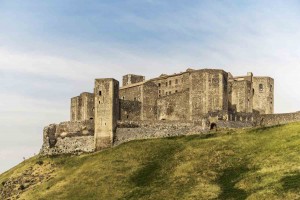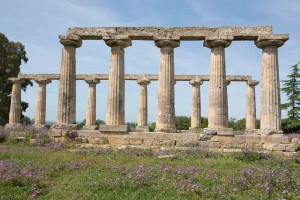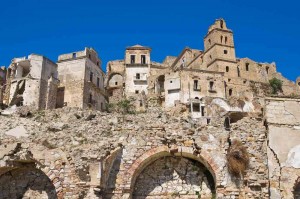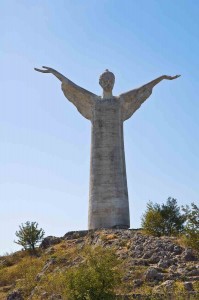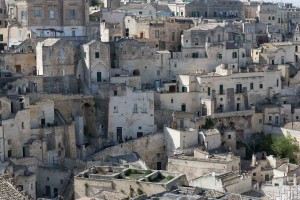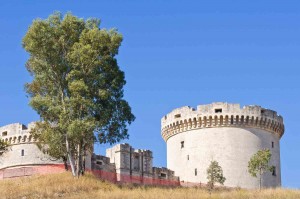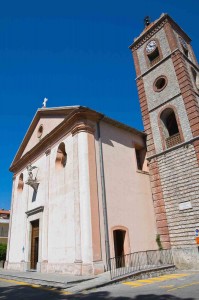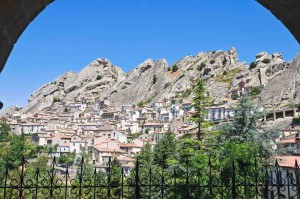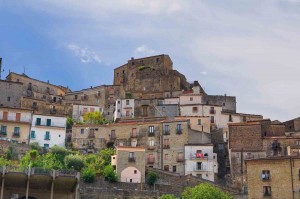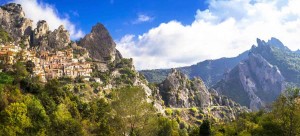Italy’s “instep”, the region of Basilicata, is a geographical marvel. Despite its southern-most location, 47% of the area are covered by mountains and always as much by hill land. While the coastal strips are rather narrow, they border on three different seas: the Adriatic Sea, the Tyrrhenian Sea and the Ionian Seas. Even you history buffs get their money’s worth thanks to settlements that can be traced back to the Stone Age. ZAINOO presents the 10 best sights of Basilicata:
Castle of Melfi
Most likely conquered by the Normans in the 11th century, the Castle of Melfi is probably the most important medieval fortress of Southern Italy. Melfi, back then still the capital of Apulia, and its castle were the site of five papal councils and further synods. Even though the architecture changed with its various owners – such as the Staufers and the Anjous – the basic medieval structures with a whopping ten towers and four entrances, only one of which is still usable today, remained. There’s a portal at said remaining entrance that has even been dated back to the 8th century.
Metaponto
The picturesque seafront at the Ionian Sea is one the reasons why Metaponto is a very popular destination for day trips these days, but its main attraction can be found a few kilometres inland at the ruins of the erstwhile Greek settlement Metapontum. Legend has it that Metapontum was founded by the creator of the Trojan horse and the city of Pisa, a man by the name of Epeios. To this day, ruins of the temple consecrated to the goddess Hera can still be seen. Various finds and relics from pre-historic times are exhibited at the Museo Archeologico Nazionale di Metaponto.
Craco
When you get closer to this village in the hills of the Gulf of Taranto, it seems as if time has stood still. Indeed, Craco is a ghost town due to landslides that damaged numerous buildings. This makes it even more exciting to take a walk through this classic old mountain village with its houses that look as if they had been carved into stone. The settlement probably originated around 540 and was populated from Greeks that had moved inland from Metaponto. Craco nowadays is a popular site for the Italian film industry.
Cristo Redentore
In 1806 the fortified citadel on the summit of San Biagio, site of the ruins of ancient Maratea, was attacked by 4,500 French soldiers. Originally, an iron summit cross was supposed to commemorate this event, but it fell victim to several lightning strikes. Businessman Stefano Rivetti ultimately built the third-largest statue of Christ in Europe and the fifth largest in the entire world using Carrara marble. The depiction of Christ the Redeemer of Maratea is unusual as he sports short hair and only little beard growth. His slight forward bending makes it seem as if the 21 m high statue with an arm-span of 19 m and a weight of approx. 400 tons is watching the sea.
Sassi di Matera
Medieval chroniclers called them a “mirror of cosmic harmony”, Italian author Carlo Levi felt reminded of Dante’s depiction of hell; the UNESCO, in turn, named them World Heritage Site. Once you stand in front of the Sassi di Matera, you will understand all of the above. The legendary cave settlements divided into Sasso Caveoso and the later constructed Sasso Barisano are located in the historic town centre of Matera. They are one of the oldest human settlements in all of Italy. Carved into limestone, excavations have found that they had already been inhabited around 7000 BC!
Tramontano Castle
Since you already are in beautiful Matera visiting the Sassi, you also need to check out Tramontano Castle. The castle on the Lapillo hill was built in the early 16th century under the aegis of Gian Carlo Tramontano, Count of Matera, outside the town walls high above the historic town centre; not to protect it, quite the contrary: Tramontano felt he’d be able to exert better control over the town this way. It comes as little surprise that he was murdered in broad daylight in 1514. Construction was halted and remained incomplete as a few more towers were yet to be built. During excavations on the site of the castles, vast subterranean water reservoirs were found amongst other things.
Chiesa di San Michele Arcangelo in Potenza
Even though the face of the current building of Potenza, capital of the region of Basilicata, doesn’t give it away, the origins of Chiesa di San Michele Arcangelo, a church consecrated to the archangel Michael, dates back to the end of the 5th century. This presumption comes from a mosaic found beneath the church floor. Today’s building probably dates back to the late 11th century and wows with its fantastic Renaissance interior that even survived bombings and earthquakes. Fittingly, one of the exhibited paintings is called “Madonna del Terremoto”, which translates as “Our Lady of the Earthquake”.
Pietrapertosa
Translated literally, the place name Pietrapertosa means “perforated stone” and comes from a large perforated rock that’s located above the village in the Lucan Dolomites. Pietrapertosa was already founded in the 8th century BC by the Pelasgians, one of the oldest Greek populations, and shows many signs of its eventful history. A great number of churches enrich this village, such as the monastery of San Francesco, which was built on the ruins of a Roman fortification, and the San Giacomo Church with frescos from the 14th to 16th century.
Castello di Valsinni
One of the most famous poets of the Renaissance lived at the Castle of Valsinni. Isabella Morra was born in Favale, the former name of this village. Her poems were only released six years after she had been murdered by her brothers who believed her to have an affair with her teacher. He, too, was snuffed out. The castle itself survived the centuries. It was probably built in the 11th century on the ruins of a Lombard fortification. Its exposed location on a hill with the old main building and impressively mounted walls makes the Castello an eye-catcher far beyond Valsinni.
Il Volo dell‘Angelo
What about seeing the beautiful Basilicata from bird’s eye view on an approx. 1.4 km long cable at a speed of up to 100 km/h? Il Volo dell’Angelo, the “Angel Flight”, operates between the two villages Pietrapertosa and Castelmezzano. You’re attached to a steel rope with a safety harness and dash high above the earth from village to village on one of the two routes that are connected via shuttle service. Due to the height and speed, you need to have good nerves and a head for heights. Your rewards are a unique thrill and probably the best view imaginable.
With its historic glory, pre-historic settlements, scenic diversity and many an adrenaline rush, the region of Basilicata, notwithstanding its somewhat disregarded status, needs to be visited and toured extensively during a holiday. Find many more tips, suggestions and tours for your next holiday in Italy on ZAINOO.
